This site contains affiliate links. As an Amazon Associate, I earn a commission from qualifying purchases at no extra cost to you. Full Disclosure Here.
Karambits seem to be everywhere in the media and Hollywood due to their eye-catching sinister look. But if you’re on this page you’re probably wondering how practical something like a karambit is actually going to be compared to a more traditional folding or fixed blade knife. What uses are there for a Karambit?
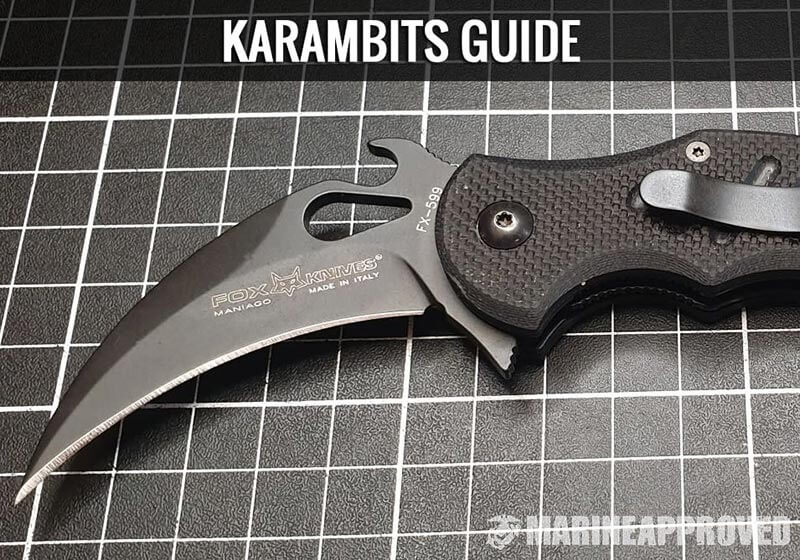
In the rest of this article, we’ll talk about everything you need to know regarding the coveted karambit and hopefully, we can help you decide if it’s a knife worth buying or a gimmick worth skipping from the perspective of someone looking for a usable and helpful tool for everyday life.
Karambit Uses (Advantages and Disadvantages)
In this section, we’ll discuss how the karambit performs for different applications.
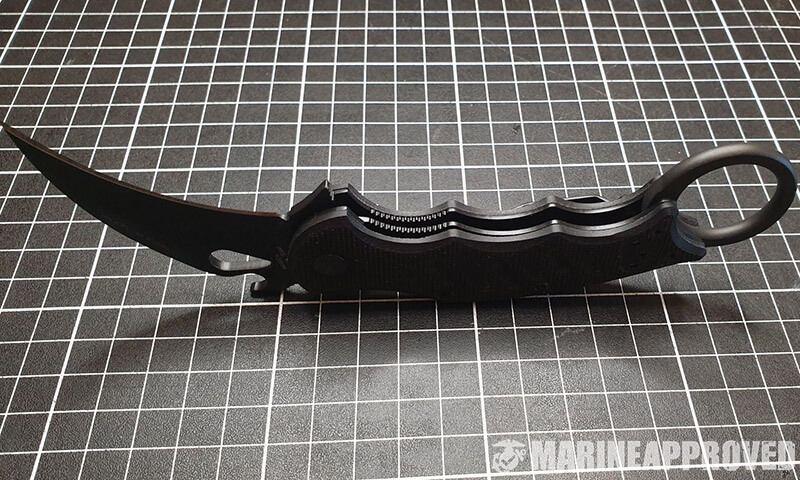
Karambits for Slicing and Skinning
Score: 3/10
Some may argue with me here but for the most part, the edge is really on the wrong side of the curve to be considered truly effective compared to its peers for skinning. Almost all other blade shapes, especially the clip point, drop point, and trailing points, are going to be favorable for skinning.
In terms of slicing, the karambit can actually perform quite well if the object is in your hand, say your holding an apple and you are making slices to pass around to your buddies, but if you are slicing on a solid surface like a cutting board, the karambit is awful because you cannot press down a majority of the blades cutting surface to the cutting board.
Karambits are excellent for slicing in a dragging and sweeping motion, for example, in a self-defense situation where you are using your knife to stave off an attacker, but for an actual tool used for everyday slicing activities, the karambit is going to be a lot more difficult and less efficient than most other blade shapes.
Karambits for Stabbing, Puncturing, and Piercing
Score: 4/10
This is kind of subjective, so we’ll start with the obvious fact that full-on piercing something, such as a car hood like the guys at Cold Steel would like to have us believe is a normal thing to do, is going to be virtually impossible as the tip is curved inward, making a thrusting motion basically useless. Of course, if you come at it at an angle, you can get some piercing action with the tip but now you’re exerting a ton of force on a tip that is not well backed by the steel and exerting a ton of force on something that’s probably relatively thin due to its grind, making for an experience that is very likely to end up in damaging your knife and possibly yourself. For anything solid that would require significant force to get the tip into, the karambit blade shape is a certain no-go.
Then there is the other side of this, the fact that the tip is made to be highly effective at puncturing soft materials when used in a slashing method. The tip of a karambit is specifically designed to dig into the material and drag the rest of the blade through it with exceptional effectiveness and a low amount of friction resistance, so if you were to have to slash against an assailant, that tip is going to produce devastating damage virtually effortlessly due to its ability to easily puncture and pull the rest of the blade through that entry point.
Karambits for Batoning
Score: 1/10
The karambit blade shape is obviously in no way designed for batoning and is likely among the worst blade shapes for this type of action. The curvature of the spine is going to make getting consistent and accurate hits quite difficult, the blade is typically going to be thin and accompanied by a similarly thin spine, making it not resistant to the shock of batoning, and overall the knife is very prone to failure if used while heavily batoning.
Karambits for Slashing
Score: 9/10
If used correctly and with ample technique, the karambit is going to be one of the most effortless slashers on the blade shape list. The tip of the karambit allows for a near-effortless puncture and the geometry of the shape allows the blade to be sucked into the entry point, causing incredible slashing ability with very low effort but with a ton of damage being done. There aren’t any other blade shapes that behave while slashing in the way the karambit does and most of them actually lend to pulling away from the material as the cutting surface is curved outward, like on a drop point, which makes them less effective near the tip, while the karambit generally pulls itself in and makes use of virtually all of its cutting surface.
There is a caveat here, though, and it’s that you could argue that having an outward curving blade, as opposed to what the karambit is, makes for slashing outward at distance in utter desperation a bit easier. The karambit has to first pierce and pull with its tip, meaning you have to make contact with the material specifically at the karambits tip, otherwise it’s likely you will do very little surface damage if any at all, while other blade shapes don’t require the tip to be involved at all, generally having long and open bellies that are sharp at any given point. The karambit is, for the normal untrained civilian, possibly a bit harder to obtain the optimum slashing capability as opposed to other blade shapes due to its more advanced learning curve and specific technique.
Karambits for Whittling
Score: 1/10
The karambit is obviously going to perform fairly awfully in terms of whittling simply because the inward curved point makes tight and precise edge work very difficult. The shape just isn’t designed in any way for this sort of thing and if this is your mission, the karambit is probably the worst shape you could choose for it.
Karambits for Prying
Score: 1/10
Of course, knives aren’t prying tools in general, but the karambit is going to fair especially awful in this department if the absolute need arises due to its overall thin and slender nature. Typically, a karambits design is focused on being able to cut and slice scythe-style as effectively as possible, meaning it needs to be thin, meaning it will have very low horizontal strength capabilities and not a lot of steel to back itself up with.
Karambits for Everyday Carry (EDC)
Score: 2/10
Unless you’re lumping in self-defense with EDC, the karambit overall just isn’t that great of a blade shape from a total utilitarian perspective. At the end of the day, I imagine a solid EDC knife being a knife that is ready to face the widest and most diverse of applications and challenges and the karambit just isn’t that. It’s not to say you couldn’t EDC a karambit, I have personally done so just to try it out and although it wasn’t necessarily awful, I almost always found myself kind of wishing I had one of my other more versatile knives with me for just about every task I encountered with my karambit. It’s a cool-looking blade shape that may spark a bit of conversation with your buddies, or perhaps some unwanted fear among bypassers, but overall it’s just not what I would define as an EDC-friendly blade shape.
Karambits for Camping and Bushcraft
Score: 2/10
The karambit is thin, light, and meant to slice through relatively soft and thin materials, making it awful for bushcraft and camping as a whole. When I think of a knife I’d take with me camping, I want something that has a beefy spine for both the possibility of batoning as well as just being thick and reliable. I also want something whose blade shape I can use in any situation, almost like an EDC style knife, but with a thick and beefed up tip that I can rely on even while putting a lot of pressure on it. The karambit just isn’t any of those things and while a very large karambit style blade can be useful if you consider slashing down things like stalks of bamboo or foliage scythe-style as bushcraft, then maybe it gets a couple of points there, but as an overall tool to take out into the wilderness with, it just doesn’t cut for it for me and would be at the bottom of the list.
Karambits for Fishing Line and Ropes
Score: 7/10
There are some karambits out there, like the Cold Steel Tiger Claw, for example, that is just excellent for quickly deploying and cutting loose your snagged up fishing line as they are razor sharp and serrated.
A huge use-case that is often overlooked for the karambit style blade is actually deployment on a fishing boat because, as anyone who’s been at rough seas would know, a boat rocking violently and unexpectedly can make using a knife relatively difficult and possibly dangerous. A karambit, with its tip, generally pointed inwards or downwards instead of straight out, greatly reduces the possibility of an accidental jabbing/stabbing-like incident and so that creates a bit of safety and peace of mind in the hands of someone who still needs a decent cutting tool in wishy-washy circumstances.
The knife you have on you and are comfortable with using is always the best knife, and if having a tip that is less lethal per accidental situation makes you more confident in using it on a boat, then that’s the best knife for that situation. The ripping and pulling motion of a karambit also makes cutting thick rope in a quick and easy fashion quite convenient, however, if you have an extremely thick rope that isn’t going to cut through no matter the blade in one go, sawing at it might be a bit less than desirable with this blade shape.
Karambits for Self Defense
Score: 9/10
Simply put, the karambit was virtually designed for this use case and so long as you have the proper training and experience, the karambit can be an excellent tool for self-defense purposes. In the hands of the untrained, though, the karambit may even be worse than something more intuitive to use, like the American Tanto, so this really just depends on whether or not you can properly deploy and use a karambit shaped blade. The karambits tip is well known to penetrate and pull the claw-shaped blade into the material it’s cutting which creates a ton of ripping and tearing type damage. A lot of karambits also have a ring at the end that can be used for some pretty brutal non-lethal blunt damage, similar to how brass knuckles would work. A true self-defense designed karambit would also encompass a double-edged blade, making that rounded spine an extremely dangerous and lethal tool that is very hard to counter and defend against. Overall, self defense is one of the most practical karambit uses.
First Response and Egress
Score: 4/10
First and foremost, unless you’re egressing from a field of drying towels on clotheslines, the karambit has very little piercing capabilities in terms of thrusting through heavy materials, like the side of a helicopter or a car door, so no points for that.
For first response, there are definitely better options, but I could see one pro being the fact that you could use a sort of hooking motion to grab something like a seat belt, and since the tip is generally pointed downwards and most civilian-use karambits are single-edged and dull along its rounded spine, once you have the belt hooked, you can saw and slice through it without worrying about hurting the person you’re trying to help. The karambit is also useful for pull-cuts when needing to quickly remove thick material like clothing or cutting the straps off of a backpack if needed.
Combat and Tactical Applications
Score: 7/10
The karambit is probably most well-known, at least in terms of modern media, as a lethal and combative tool capable of great and precise destruction. This is true, and there is even an entire martial art designated towards using tools like the karambit in this manner called Kali.
A lot of media today, like your typical action-packed shoot em’ up movies, will have you believe that soldiers and operators use knives on a regular basis to dispatch enemies and unfortunately the reality is that a real soldier has much more effective weapons at their disposal and their knives, although almost always carried, are used for survival and EDC-like purposes a lot more than they are used for actual violence. Most tactical knives are either called tactical because of their style and design which is really just a subjective aesthetic kind of thing in which the karambit fits the bill, or are dubbed tactical because they are well designed to be used in a wide array of situations, mostly involved in setting up camp, working on vehicles, and for weapon/gear maintenance. In this case, the karambit is a pretty awful choice because it’s just not as versatile as many of our other options.
Cooking
Score: 4/10
The karambit just isn’t that great in the kitchen. We have all at least seen part of an episode of some kind of chef-based TV show, cook-off event, or even one of those cheeky social media videos of preparing tasty foods, so ask yourself, have you ever seen any of them using a karambit or karambit shaped blade? Probably not. Sure, you can make quick work of divvying up some apple slices to the boys at camp, but in reality, the karambit just isn’t a great knife for slicing up chicken tenders, dicing down the onions, chopping up the parsley, or cubing a juicing slab of steak.
If you’d like to check out a more comprehensive guide on all knife blade shapes.
Karambit Use Case Assessment Table
| Use Case | Overall Score |
| Slicing and Skinning | 3 out of 10 |
| Stabbing and Puncturing | 4 out of 10 |
| Batoning | 1 out of 10 |
| Slashing | 9 out of 10 |
| Whittling | 1 out of 10 |
| Prying | 1 out of 10 |
| Everyday Carry (EDC) | 2 out of 10 |
| Camping and Bushcraft | 2 out of 10 |
| Fishing Line and Ropes | 7 out of 10 |
| Self Defense | 9 out of 10 |
| First Response and Egress | 4 out of 10 |
| Combat and Tactical | 7 out of 10 |
| Cooking | 4 out of 10 |
The Karambit Talon Blade Shape Versus Other Popular Blade Shapes
Karambit vs Drop Point Knives
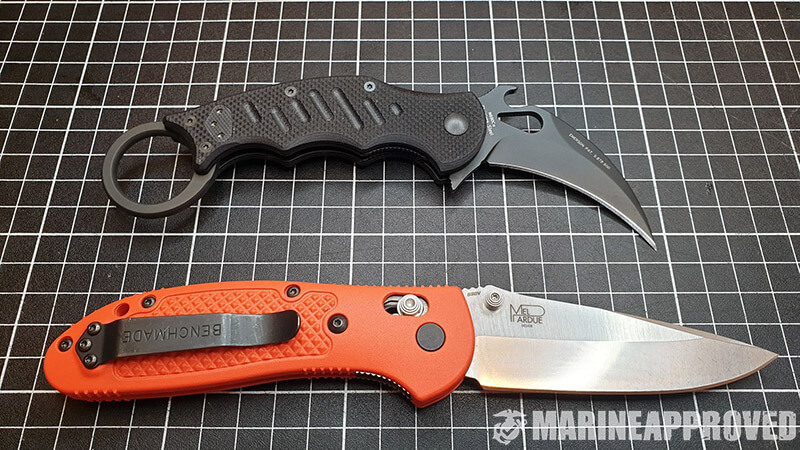
The drop point is a far more versatile and general-use-oriented blade shape that is probably one of the most user-friendly options on the market today. The karambit is the exact opposite of that, being really only useful for slashing through thin materials and having a relatively steep learning curve to use properly and safely. The only advantage the karambit has over the drop point is its ability to dive into soft materials and pull itself through, causing immense damage, while the drop point actually does less damage as you near the tip where the blade drops off and you lose your mechanical advantage.
Karambit vs Tanto Knives
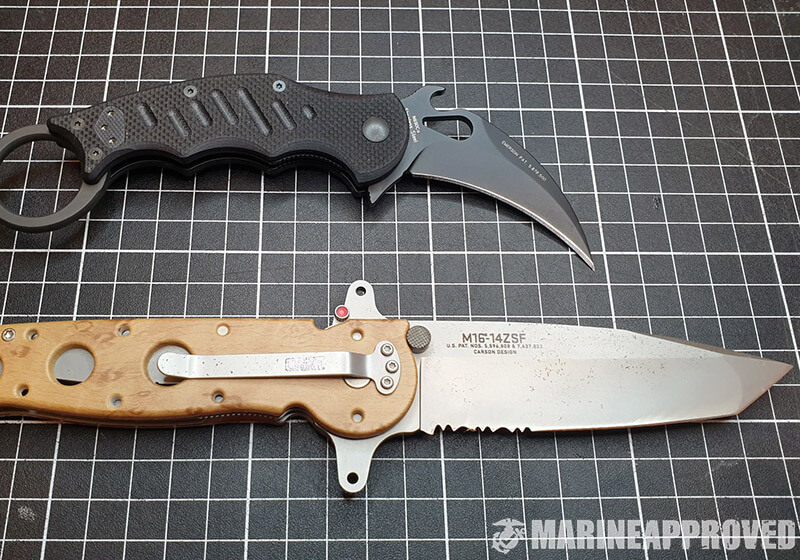
The tanto and the American tanto are excellent blade shapes for piercing and thrusting as they encompass extremely strong tips with a lot of material backing them up whereas a thrusting piercing motion for a karambit is virtually impossible. Most tanto blades are also a lot more versatile with a long flat or semi-flat blade design that encompasses a lot of outward cutting surface while the karambit has a heavily curved blade. If you need a blade that is capable of putting itself through a car hood, the obvious choice would be the tanto, especially if you think you’ll be dealing with assailants wearing soft body armor, as the karambit won’t do any damage at all to while a tanto may be able to penetrate through.
Karambit vs Reverse Tanto Knives
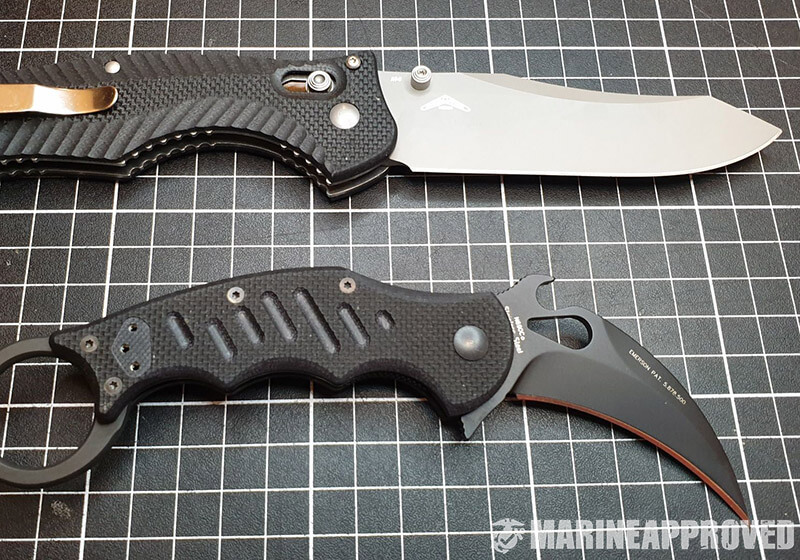
Similar to the drop point, the reverse tanto is going to be far more versatile and easier to use for the average person than the karambit. I don’t want to sound redundant so we’ll just leave it at this – if you need something capable of being a well-rounded EDC, the reverse tanto is the better option due to its strength, durability, and versatility, while the karambit is really just a better alternative if you plan to train and utilize it as a self-defense tool.
Karambit vs Sheepsfoot Knives
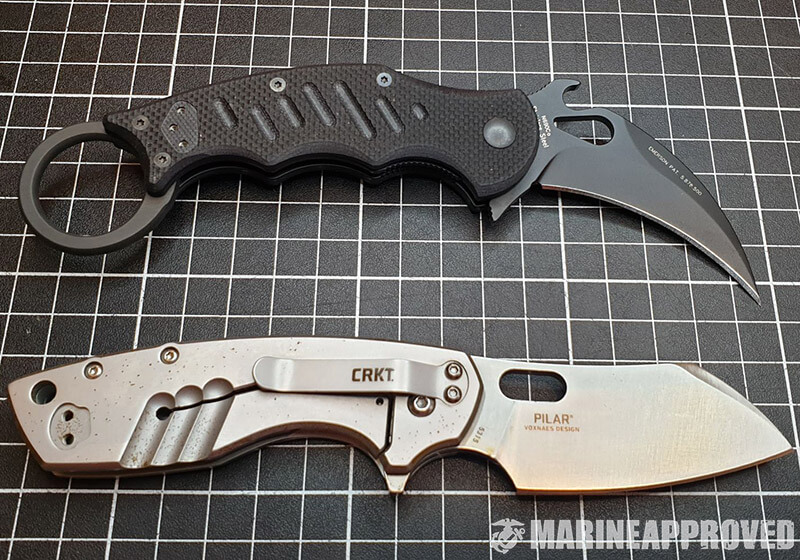
I mentioned earlier how the karambit is popular among fishermen due to its tip not projecting straight out the front of the blade, making it a bit safer to use on a rolling and rocking boat at sea, and so the sheepsfoot and the karambit would share this attribute, but that’s about the only thing they share. The sheepsfoot makes for a good slicer, especially on a hard surface like a cutting board, whereas the karambit is virtually useless in that regard, but of course, the sheepsfoots ability to cause damage to an assailant wouldn’t be even close to the karambits lethality. All in all, the karambit is a lot more of a weapon while the sheepsfoot is a handy tool meant to be durable and relatively versatile.
Karambit vs Clip Point Knives
The differences here are similar to the drop point and reverse tanto whereas the clip point offers a long cutting belly with a slow slope up to the tip, making it far more versatile and easier to use across basically all categories as opposed to the karambit. The karambit really only excels over the clip point in long outward slashing capabilities and pull-cutting efficiency.
Karambit vs Trailing Point Knives
The trailing point is basically the opposite of the karambit, where the tip is facing upwards and outwards versus the karambits inward and downward-facing tip. The trailing point is often a favorite among those looking for something to skin and slice, for example, cleaning fish. The karambit is tough to use for this because its inward-facing cutting surface is difficult to use in a small and precise manner. The karambit in a defensive slashing situation, though, is going to be more devastating as its blade design helps it to claw into the assailant while the trailing point, as you get near the tip, losing its mechanical advantage and the damage slopes off.
Brief History of Karambits
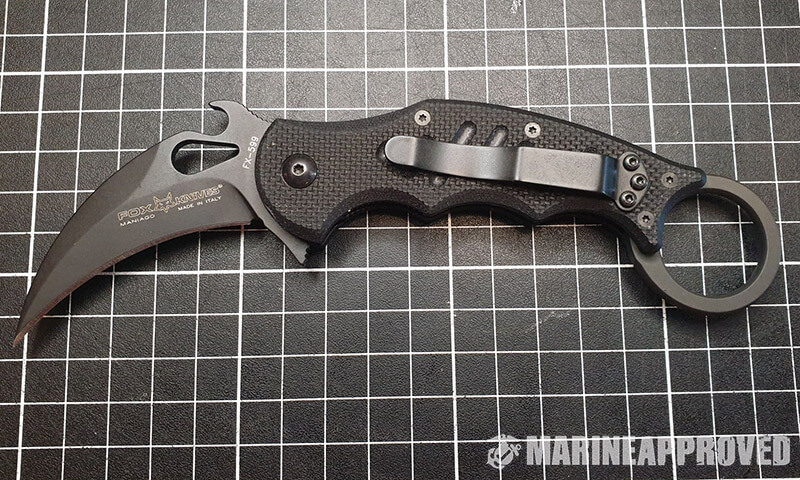
Karambits were originally used as farming tools as there have been many records found of people using what really looks like miniature sicles (Filipino Garab or Karit) for farming, especially popular in South East Asian island nations like the Philippines and Indonesia for growing rice and various other agricultural implementations.
Of course, humans often find themselves in a conflict in one way or another and since this tool was very popular in the region, it quickly underwent design changes that morphed this blade shape into a more lethal and combat-oriented piece of hardware, namely by making them more curved and double-edged along with a very strong finger ring that can be used as a blunt attack as opposed to the blade when necessary.
The Minangkabau society of West Sumatra is thought to be the first to weaponize the karambit and over the years, the tool mom and pop used to cultivate their rice fields turned into a deadly tiger claw-shaped blade ripping through people on the battlefield. The most popular deployment of karambits in battle during this time period was as a secondary weapon after the primary weapon, the spear, was thrown or otherwise unequipped or damaged.
Coming into modern times, the karambit was quickly adopted in the world of martial arts, making its debut in Filipino fighting styles. The famous Doug Marcaida has some interesting videos on the use of the karambit in Filipino martial arts that you can check out here. One of the most popular martial arts that embrace the use of the karambit is a Philipino style of fighting called “Kali”.
Popularity and Accessibility of the Karambit
If you go to your local flea market, you’ll probably find yourself several choices of karambits and hey, they’ll likely be super cheap too. Well, therein lies our first issue. While there is quite a bit of availability for karambits of questionable and, some definitely horrendous quality, it’s not actually that easy to find a fancy karambit with a super steel and all the goodies we like to see on other types of knives that we would actually recommend and rely on.
Karambits are kind of seasonal. Not seasonal like Christmas lights at your local department store but their popularity does seem to go up at times and drop down other times and this tends to follow popular media, most specifically, movies, TV shows, and video games where the karambit is a popular centerpiece, take the demon “Maze” from Lucifer as an example, as there is a ton of search volume on the internet that is dedicated to what those karambits she uses might be.
In reality, and I don’t have specific statistics for this but I think it’s a safe assumption, the karambit is typically finding its popularity as a cool novelty item that’s often overstated for its lethality by the media instead of actually seeing heavy everyday usage.
With that said, a lot of karambits are designed to appeal to this crowd and since this crowd doesn’t typically intend on using their karambit in harsh conditions or under heavy stress, the quality is often sacrificed for lower quality materials so they can attain lower and more attractive price points than their competitors. If you don’t care about knife nerd stuff, there are tons of tacticool looking karambit-equipped knives all over the place, just don’t expect them to perform very well in real-world use cases.
For those of us who appreciate the steel composition, edge geometry, and consider handle material to be a make or break for our daily comfort, finding karambits that are actually high quality and utilize what we as knife nuts know to be high-quality materials can be considerably more difficult than a majority of the other blade shapes.
All in all, in terms of the regular consumer market, there really are only just a handful of the big reputable knife brands that offer a karambit and it’s not uncommon to find one you like with all the goodies you are willing to pay for, only for it to be out of stock. With that said, there are typically options available if you’re willing to either pay attention, pay loads of money, and be patient or perhaps have a few concessions in terms of your ideal knife characteristics.
Popular Steel Types Used in Karambit Blades
Steel composition is going to determine the attributes of your blade which include resistance to corrosion, how sharp an edge can be sharpened, how well the blade retains its edge, tensile strength, hardness, etc. In reality, shopping around for a karambit is going to be pretty similar when it comes to steel choices as standard pocket knives or fixed blade knives are, with the exception that edge retention might be a bit more important as sharpening a karambit can be a bit tedious and difficult for some.
I’ll cover a few of the most popular choices that are Marine Approved but if you’d like a more extensive rundown of all the steel materials you might find on the market today, head over to our guide on knife steels here.
A2
This is a tool steel commonly used due to its 5% chromium profile that creates a very high level of hardness and steel stability. A2 is a steel that isn’t exactly the best in any category but is a decent all-around steel that isn’t exceptionally expensive. A lot of manufacturers really like using A2 because it’s one of the easier high hardness level steels to machine and polish, while it’s also relatively easy to maintain and resharpen compared to super steels. A2 is a pretty decent middle ground between price and performance and for most people, A2 will be plenty strong for the normal EDC operations.
Bohler N690Co
This is a relatively premium, although technically not a “super steel”, that is increasing in popularity seemingly everywhere but in the US. Bohler N690Co is steel from Europe and contains a high level of carbon mixed with a low dose of cobalt, manganese, silicon, and molybdenum, along with a hefty dose of chromium to create a steel that is inherently strong and balanced between strength and toughness but is an exceptional performing steel overall. You’ll find this option on a lot of the popular Fox Knives Karambits, which are some Marine Approved favorites!
D2
D2 is also a tool steel and somewhat similar to A2, this high carbon and chromium steel encompasses a tradeoff here where D2 can be a bit harder overall making it resist abuse and wear but a tad less tough than A2 is in general. D2 is a pretty good steel for those of you shopping in the mid-range category in terms of price. D2 is a steel that does not easily disappoint at very reasonable prices but of course, falls short of super steels.
VG-10
VG-10 steel is the industry go-to when it comes to resistance to corrosion without sacrificing literally everything else. There are steels that might resist corrosion a little better but they sacrifice a lot of their strength and hardness to achieve this. VG-10 has insane resistance to corrosion while still being strong and durable enough to be trustworthy and wholesome. VG-10 steel is going to be very popular among Spyderco, which makes an awesome karambit that we talk about in this guide.
Crucible 154CM
This is martensitic steel similar to 440C but with the addition of molybdenum to raise its toughness and complement its other characteristics. 154CM is a very interesting steel that, although I wouldn’t say is super popular right now, is certainly gaining traction. Some of my favorite knives I own consist of 154CM and overall, I have been very impressed with the price. 154CM steel is generally known as the tough guy, a steel that is literally designed to be beaten and abused and keep on trucking along. If you are going to buy a karambit and beat the hell out of it, 154CM steel is a top-notch choice.
8Cr13MoV
This is a rather low-cost Chinese stainless steel that’s pretty similar to AUS 8 steel and is a relatively low-end option but considering the price, is a decent value. I wouldn’t normally recommend low-tier steel like this unless you absolutely cannot afford high-tier steel and if that’s the case, then this is the cheap steel I’d recommend. It’s a high carbon mixed with chromium kind of platform where you can expect a decent level of hardness but a lack of overall durability and strength. These are the kinds of blades you buy on a budget where you just want to have something around to open boxes, cut loose strings off your jacket, or to just have a knife to undergo basic ever-so-often daily tasks. These aren’t really blades I’d trust with my life out in the desert or the jungle, but they are capable blades that provide decent performance for the price, which is typically pretty low.
1095 Carbon Steel
1095 is a long-term tried and true steel that is about as average as it can possibly get, perhaps even a little below average now with all the new additions we’ve got to the mid-range of steels recently. 1095 can be made to be very hard but unfortunately, this makes it relatively brittle and must be thick in order to resist snapping. You won’t find many 1095 carbon steel blades being used in a folding fashion as these are primarily reserved for fixed blades so that they can be made to be very thick and hefty. In decent thickness, 1095 is decent steel that you can usually get for a pretty decent price.
Common Grind Types for a Karambit Shaped Blade
The whole premise of the karambit is to create a blade that is able to easily and efficiently slice and tear its way through fibers and flesh so it makes a lot of sense why most karambits are going to be found with a hollow or thin flat grind.
Simply put, these grinds allow the blade to be relatively thin which gives them a lower drag when entering and slicing its target. Other grinds that are thicker for high impact and durability and are notorious for creating a wedging effect, like a Scandi or V-grind, aren’t going to be ideal for a karambit because they will slow down how fast and effectively the blade can move through material and perhaps even get caught or become hard to pull out and reset for another movement.
On rare occasions, you may find karambit blades with a sort of chisel grind which makes them able to slightly beef up the rear of a razor-sharp edge, giving them a slight boost in durability but making the overall skill level to use them efficiently a bit higher since the angle of entry is more limited than it would be with a hollow or flat grind. A chisel grind is also pretty popular among karambits that are much larger in nature and to be used as a tool, for example, in a field of rice stalks that need to be cut quickly with a single slashing motion where the angle of the cutting motion is repetitive.
This makes the traditional karambit very nimble but of course, anything with a hollow grind is going to encompass something very thin and, unless the blade steel is exceptionally strong, lends itself to being easy to chip and break.
Hollow grinds are excellent slicers but for anything heavy, like batoning through a piece of wood, the blade is at severe risk of failure. This is a big reason why I don’t necessarily recommend a karambit as an EDC or really anything other than a novelty collector’s knife or something used specifically for self-defense purposes as they are not generally considered to be reliable or especially durable in a survival or heavy use situation.
The grind of the blade is arguably just as important to the knife’s overall performance and usefulness across different tasks as is the shape and materials. If you haven’t already, check out the Marine Approved guide on knife blade grinds here.
Marine Approved Examples of Folding Karambit Blades
- Fox Knives 599
- Spyderco Karahawk
- Cold Steel Tiger Claw
Marine Approved Examples of Fixed Blade karambit Blades
- Fox Knives FX-598
- Boker Magnum Spike
- CRKT Keramin
Wrap Up
Karambits blades certainly aren’t for everyone and to be totally honest, here at Marine Approved, we really appreciate having gear that is as versatile as it can possibly be and gear that gets our everyday tasks done as quick as possible, and unfortunately, your run of the mill karambit doesn’t really check those boxes in our particular use cases.
With that said, karambits are definitely a very interesting addition to any knife collection or something to tote around if being different and having something unique is important to you and if you’re willing to put in the time and energy to receive proper training, the karambit can be a very useful and lethal tool to add to your personal defense arsenal.
The karambit is certainly a neat and handy blade design but as any knife enthusiast knows, a fancy blade shape and super steel doesn’t do you much good without a solid handle to use it with, so make sure to check out the Marine Approved guide on knife handle materials before you go shopping for a tiger-claw looking karambit-equipped blade!
